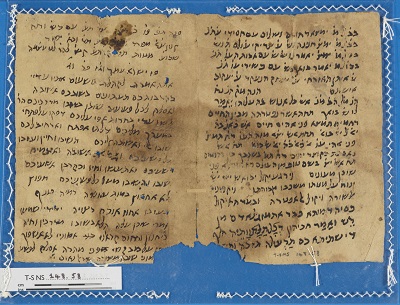Mourning in Late Antiquity: T-S NS 148.58
Laura Lieber (Duke University)
We know little of the lived experiences of the majority of Jews in the world of Late Antiquity. The Genizah can however provide a glimpse, albeit partial and blurry, of Jewish life in the Land of Israel in the 4th to the 7th centuries CE. This period, which encompassed the consolidation of Jewish textual traditions, the rise of imperial Christianity, and the arrival of Islam, also witnessed the birth of a literary tradition that crossed many of the boundaries of the period: religious, or liturgical, poetry. Alongside this body of work is a small, precious collection of poems in the vernacular of the Jews of Late Ancient Palestine: Jewish Palestinian Aramaic (JPA) poetry. These poems are of a popular character and were composed not only for holidays but also lifecycle events, and so they offer a rare window through which Jews’ routine, lived experience during this obscure time can be perceived.
This fragment, T-S NS 148.58 folio 1v, illustrates one way in which the death of an individual was marked by the community.[1] It preserves a ritual rubric for the end of a funeral, in which performative cues to the congregation are followed by the opening lines of a poem addressed to the mourners (Sokoloff & Yahalom 1999: 328–329; Lieber 2018: 209). The extant portion of the poem weaves together a philosophical acceptance of the universality of death—the fate of humanity from the time of Adam—with a recognition of the inevitable pain it nonetheless causes. It sketches a vivid picture of a community assembled in mourning, poised to take their leave from a funeral in full awareness of their own mortality in the face of others’ grief. The absence of formal structural devices makes it impossible to estimate what fraction of the full poem these lines represent.
T-S NS 148.58, the JPA eulogy is on f. 1v (the right-hand leaf, towards the bottom)
Transcription:
ויקפו פי אלשורה
ויקול אלאפטרה ובעדהא יקול
כסיה דמותא כבר אתמזג לאדם מן רֵ[י]ש
ואַמַר חכיהון דכל חַלָ(ת)וָותֵיה
חלף די שתיתא כס תַרְעילה
תזכה ותש[תי כס תנחומין]
…
Translation:
Let them form up into rows And let the aftarah (farewell) be spoken and afterward, let it be said:
The cup of death was mixed from the (time of) the first human
And it embitters the palate, (negating) any of its sweetness
Because you have drunk the bitter draught of the cup of reeling [2]
May you merit to drin[k from the cup of consolation][3]
The text provides instructions for mourners in the context of the eulogy: it delineates how they should station themselves during the offering of the eulogy (the ‘farewell’ to the deceased); and it provides a script for the community to recite to the mourners when the eulogy is over. A motif of three cups governs the communal response: the cup of death, from which the deceased (like all mortals) was destined to drink; the cup of reeling, from which the mourners have tasted; and the cup of consolation, from which the mourners drink following the funeral.
With its juxtaposition of ritual instructions and congregational language, this passage offers a glimpse not only into an understanding of death but also the practices and purposes of mourning. The poet presents death in what we might call relatively stoic terms: death is the universal fate of all people and comfort comes from a cup of wine, not by means of an afterlife or through the legacies of progeny or good deeds. The poet’s focus is exclusively on the human sphere: the deceased, the bereaved, and the community. Taken as a whole, this fragment offers a glimpse into a very specific ritual moment that is both painfully personal and inescapably universal, as ritual and poetry lend shape to the mourning process.
Bibliography:
Sokoloff, M. & Yahalom, J. (1999). שירת בני מערבא: שירים ארמיים של יהודי ארץ ישראל בתקופת הביזנטית (‘Jewish Palestinian Aramaic Poetry from Late Antiquity’; Hebrew; Jerusalem: Israel Academy of Sciences and Humanities).
Kister, M. (2007). ‘Jewish Aramaic Poems from Byzantine Palestine and their Setting’, Tarbiz 76, 105–184.
Lieber, L. S. (2018). Jewish Aramaic Poetry from Late Antiquity (Leiden: Brill).
Dr Lieber’s book on this subject ‘Jewish Aramaic Poetry from Late Antiquity’ will be published this month in Brill’s Cambridge Genizah Studies series
[1] The manuscript is a later copy from the Classical Genizah Period, and shows the longevity of some of these Aramaic poems, as they were still being copied, and presumably used, many centuries after their composition and the loss of the Aramaic vernacular.
[2] Isa 51:22; see also Zech 12:2 and EstR 4:2 (8a).
[3] ‘Cup of consolation’ appears in Jer. 16:7, where mourners are denied this comfort in bereavement; see also GenR 67:9 (Theodor-Albeck ed. 766). The end of the line is restored as in Kister (2007: 167). Kister bases his restoration on another eulogy poem which is preserved in a manuscript at the Russian National Library in St. Petersburg (MS Antonin 112).
Cite this article
(2018). Mourning in Late Antiquity: T-S NS 148.58. [Genizah Research Unit, Fragment of the Month, April 2018]. https://doi.org/10.17863/CAM.28077
If you enjoyed this Fragment of the Month, you can find others here.
Contact us: genizah@lib.cam.ac.uk
The zoomable images are produced using Cloud Zoom, a jQueryimage zoom plugin:
Cloud Zoom, Copyright (c) 2010, R Cecco, www.professorcloud.com
Licensed under the MIT License

